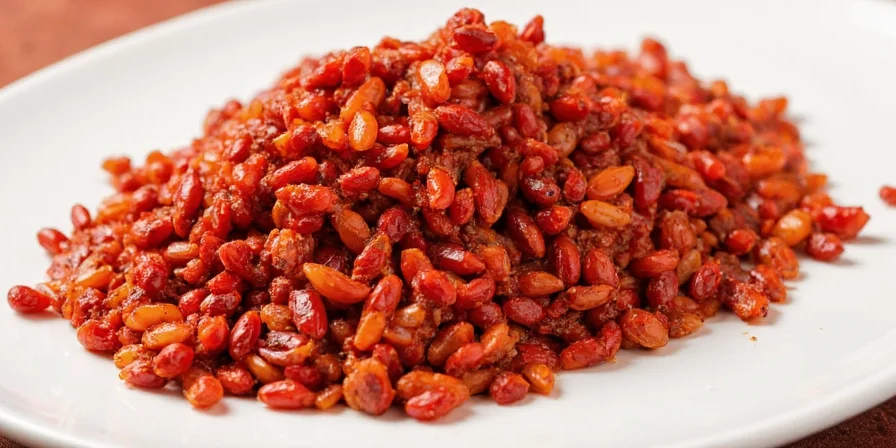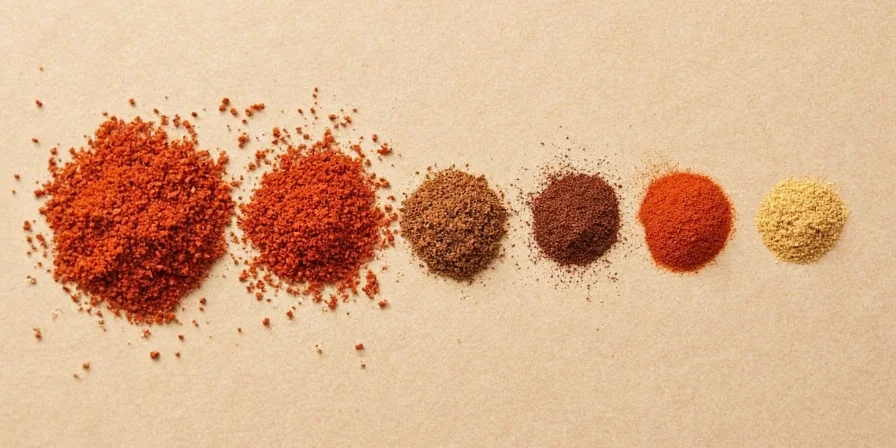Aleppo pepper is a moderately spicy, sun-dried Syrian chili flake with a complex flavor profile featuring fruity, smoky notes and gradual warmth (5,000-10,000 Scoville units). It's milder than cayenne but hotter than paprika, making it perfect for Mediterranean and Middle Eastern dishes. Unlike generic red pepper flakes, authentic Aleppo pepper contains olive oil for preservation and has a distinctive burgundy color. Here's exactly how to use it, substitute it, and store it properly.
Table of Contents
- What Is Aleppo Pepper? (Simple Explanation)
- Heat Level Comparison: Aleppo vs Jalapeño vs Cayenne
- 3 Best Aleppo Pepper Substitutes (With Ratios)
- Where to Buy Authentic Aleppo Pepper
- Flavor Profile: What Makes It Special
- How to Use Aleppo Pepper: 5 Practical Applications
- Buying and Storing: Shelf-Life Science
- Pro Techniques: Maximizing Flavor
- Cultural Significance and Quality Factors
What Is Aleppo Pepper? (Simple Explanation)
Aleppo pepper (Capsicum annuum) is a sun-dried, coarse flake chili originating from Syria's Aleppo region, now primarily grown in Turkey. Unlike regular red pepper flakes (usually cayenne), authentic Aleppo pepper has:
- A distinctive burgundy-red color (not bright red)
- A slight oil sheen from olive oil coating during processing
- A moderate heat level (5,000-10,000 Scoville units)
- Complex flavor notes: fruity, slightly salty, with smoky undertones

It's commonly mistaken for generic "crushed red pepper," but they're completely different products. True Aleppo pepper undergoes a six-week sun-drying process and is treated with olive oil and salt, creating its signature flavor complexity.
Heat Level Comparison: Aleppo vs Jalapeño vs Cayenne
Aleppo pepper sits between poblano and jalapeño on the heat scale (5,000-10,000 Scoville units), but feels milder due to its oil-soluble heat compounds. This creates gradual warmth without sharp spikes—perfect for dishes where you want flavor without overwhelming heat.
| Pepper | Scoville Range | Heat Level (Compared to Jalapeño) | Best For |
|---|---|---|---|
| Aleppo | 5,000-10,000 | ½ to 1 jalapeño | Finishing dishes, dressings, roasted vegetables |
| Jalapeño | 2,500-8,000 | 1 jalapeño | Salsas, nachos, fresh applications |
| Cayenne Flakes | 30,000-50,000 | 6-8 jalapeños | Cooking into sauces, baking |

Unlike cayenne flakes which create immediate burning sensation, Aleppo delivers warming sensation that builds slowly and fades cleanly without bitterness—making it ideal for subtle flavor enhancement.
3 Best Aleppo Pepper Substitutes (With Ratios)
If you can't find authentic Aleppo pepper, these substitutions work for most recipes:
| Substitute | Ratio | When to Use | Limitations |
|---|---|---|---|
| 1 part paprika + ¼ part cayenne | 1:1 | When cooking into dishes | Lacks oil solubility, won't work for finishing |
| Maras pepper | 1:1 | For finishing dishes | Slightly hotter, less fruity |
| Ancho chili powder | ¾:1 | For dry rubs and baking | Sweeter, less complex |

Pro tip: For finishing dishes (like sprinkling on hummus), use Maras pepper. For cooking into dishes, use the paprika-cayenne blend. Never substitute with regular red pepper flakes—they're too hot and lack Aleppo's nuanced flavor.
Where to Buy Authentic Aleppo Pepper
Authentic Aleppo pepper can be found at:
- Specialty spice shops: Kalustyan's, Spice House, Penzeys (look for "Halaby pepper" labeling)
- Online retailers: Amazon (check seller reputation), iGourmet, World Spice Merchants
- International markets: Middle Eastern grocery stores (often labeled as "pul biber")

How to verify authenticity:
- Look for visible oil sheen on the flakes
- Color should be deep burgundy, not bright red
- Should contain coarse flakes with minimal powder
- Price point: $12-$20 for 2oz (significantly cheaper indicates imitation)
Avoid products labeled simply as "Aleppo style"—these are usually blends that lack authentic flavor profile.
Flavor Profile: What Makes It Special
Aleppo pepper operates on multiple sensory dimensions, creating layered effects impossible to capture with single-note chilies. Its magic lies in the interaction between volatile compounds released at different temperatures.
| Compound | Release Temperature | Sensory Impact |
|---|---|---|
| 6-Vinylpyridine | 140°F (60°C) | Fruity apricot notes |
| Guaiacol | 212°F (100°C) | Smoky depth |
| Capsaicinoids | 350°F+ (177°C+) | Gradual warmth (not sharp heat) |

This thermal-dependent flavor release explains why Aleppo excels in both raw applications (salad dressings) and high-heat cooking (searing)—a versatility absent in single-temperature chilies.
How to Use Aleppo Pepper: 5 Practical Applications
Maximize impact by aligning Aleppo's compound release with cooking stages:
- Finishing touch: Sprinkle on finished dishes like hummus, grilled meats, or roasted vegetables
- Dressings & dips: Mix with olive oil for 20 minutes before using (activates fruit notes)
- Marinades: Combine with yogurt or tahini for meats (oil solubility enhances flavor absorption)
- Bread seasoning: Mix with sesame seeds for mana'ish (Middle Eastern flatbread)
- Pasta boost: Add to tomato sauce during last 5 minutes of cooking for subtle warmth

What NOT to do: Avoid high-heat frying applications above 375°F (190°C)—this degrades delicate flavor compounds while maximizing harsh capsaicin release. Also don't use in baking where dry heat won't activate its oil-soluble compounds.
Buying and Storing: Shelf-Life Science
Authentic Aleppo pepper contains 8-12% olive oil content—visible as slight sheen on flakes. This creates unique storage challenges:
- Container: Use amber glass (blocks UV light that degrades flavor)
- Air exposure: Headspace causes 40% flavor loss in 60 days (vacuum-seal for longevity)
- Humidity: Keep below 55% (include silica packets to prevent mold)
- Temperature: Store below 70°F (21°C)—heat accelerates flavor degradation by 300%

Properly stored, authentic Aleppo pepper maintains peak quality for 6-8 months. Signs of degradation include faded color, loss of oil sheen, and diminished aroma.
Pro Techniques: Maximizing Flavor
Advanced applications for home cooks:
- Compound isolation: Bloom in warm oil (140°F/60°C) for 10 minutes to extract fruit notes before adding to dressings
- Acid pairing: Mix with lemon or pomegranate molasses to enhance fruit notes
- Texture control: Pulse in spice grinder for 3 seconds to increase surface area without releasing bitter seeds
- Heat sequencing: Add mid-cook for stews, then finish with raw flakes for top notes
- Fat pairing: Match oil types to desired effect (olive oil=fruity, avocado oil=smoky)

Measure extraction time precisely—over-blooming past 15 minutes creates bitterness from seed compounds.
Cultural Significance and Quality Factors
Aleppo pepper represents more than flavor—it's tied to Syria's pre-war culinary landscape. Historically traded through Aleppo's ancient souks, its production declined after 2012 due to disrupted supply chains. Modern "Aleppo" pepper often originates from Turkish growers using Syrian seeds. This geopolitical context explains price fluctuations and quality variations.
When chefs specify authentic sources, they support displaced farming communities. Look for brands that explicitly mention Syrian sourcing or refugee-supported agriculture for the most authentic experience and social impact.
Frequently Asked Questions
- Why does my Aleppo pepper taste bitter?
- Bitterness indicates either excessive grinding (releasing seed compounds) or exposure to high heat. Use coarsely cracked flakes and avoid temperatures above 350°F (177°C).
- Can I substitute Aleppo pepper in baking?
- Not recommended. Its oil-soluble compounds don't activate properly in dry-heat applications. Use ancho chili powder for chocolate-based recipes instead.
- How do I verify authentic Aleppo pepper?
- Check for: 1) Visible oil sheen, 2) Deep burgundy (not brick red) color, 3) Absence of fine powder (indicates over-processing). Authentic products list "Halaby pepper" on packaging.
- Does Aleppo pepper lose heat over time?
- Yes—its capsaicin degrades 30% faster than cayenne due to oil content. Store in vacuum-sealed containers below 70°F (21°C) for maximum shelf life.
Conclusion: Practical Integration Guide
Aleppo pepper offers home cooks an accessible way to add professional-level flavor complexity to everyday dishes. By understanding its moderate heat level, proper storage requirements, and strategic applications, you can elevate Mediterranean and Middle Eastern dishes with authentic flavor. Focus on using it as a finishing spice for maximum impact, store it properly to maintain quality, and verify authenticity when purchasing. This versatile chili flake bridges the gap between heat and flavor—providing just enough warmth to enhance dishes without overwhelming them, making it a valuable addition to any home cook's spice collection.

Start with simple applications like sprinkling on hummus or mixing into olive oil for bread dipping, then experiment with more advanced techniques as you become familiar with its unique properties.











 浙公网安备
33010002000092号
浙公网安备
33010002000092号 浙B2-20120091-4
浙B2-20120091-4